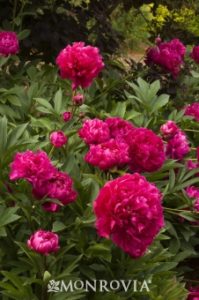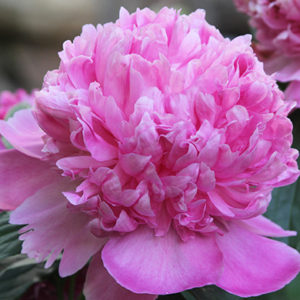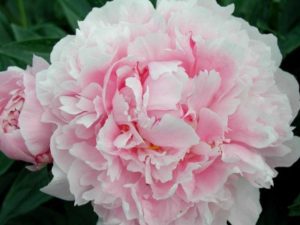Pretty in Peony
When it comes to a traditional plant and most recognizable flower, nothing compares to the peony. The large, fluffy and fragrant blooms are stunning in vases and late spring wedding bouquets. The plants themselves are so hardy and reliable that not only did your grandmother grow them but her grandmother probably did too. Once they are established, peonies are durable and low maintenance, as well as deer resistant. Many new gardeners seem to find peonies daunting or troublesome but with a bit of care when planting, you’ll soon find out how much of an asset they are to any flower bed.
Peonies have quite the long history with gardeners. They were popular in Europe in the 1780s when they were introduced from China and Japan. Using them in the cut flower trade started in the 1900s. You can find peonies in some of the oldest cemeteries and homesteads in the US. Many of the varieties that were introduced in the 1800s are still sold today, including the deep red “ Karl Rosenfield” and the double pink “Mons Jules Elie.” Chances are you have one of these in your garden.
There are hundreds of varieties of peonies now thanks to many devoted hobbyists and breeders throughout Europe and the United States. Blooms are usually reds, pinks and whites but yellow is becoming more commonly found. There is also a wide range of bloom types – single, semi-double, double, anemone and Japanese. Broad leaf types are most familiar but delicate fern-leaf varieties are becoming more popular. There are even tree peonies that have woody stems that do not get cut down, grow to 5-6 feet tall and make quite a statement although are a bit more difficult to establish.
Planting
Peonies have easy requirements. They prefer at least 6 hours of sun a day. While they will tolerate light shade, they will bloom less. Good air circulation, well-drained soil and plenty of space make for the best plants. Most varieties grow two to three feet tall and wide and are hardy to zone 3. Blooming happens between late May and late June, depending on variety. And if you cut them when the buds are showing color and soft, they will be long lasting.
Dividing
Peonies rarely need division. Unless they are too big for their space, you are sharing with a friend or taking some from the old farmstead, you can leave them be. Fall is the best time for dividing. Cut back any remaining foliage and dig the whole plant in one clump. Knock off most of the soil and wash with a bit of water so you can clearly see the eyes. Eyes are the growing points of the plant and should be pink or red and firm.
Use a sharp knife to cut apart the clump. Make sure each section has at least 4- 6 eyes and enough roots to help it reestablish. The main clump can go back in the original hole, making sure to fill all the gaps in with soil and water thoroughly.
To plant a new root, dig a hole at least deep and wide enough to fit the division and it’s roots. Going a bit bigger is ok too as it allows you to add a bit of compost. Add some fertilizer or bone meal to the hole as well. Create a mound in the center of the hole. The most crucial part of planting is to position the eyes so they are just 1 ½ to 2 inches below the surface. Press soil firmly around the roots and water thoroughly. Make sure the root or soil has not settled too much and affected the depth of the eyes.
After planting or in early spring, you might want to consider adding some support. Peony blooms are heavy and the plant will look better. Staking, decorative fences or grow-through supports are great options. Just remember to place them before the growth gets too tall.
Pests and Diseases
Peonies have few pest and disease problems. The most common issue people ask about is no blooms. This can be from a few factors that are simple to remedy. The plant may be too young. Peonies rarely bloom the first year after planting and it often takes three years before you see abundant blooms. They may be planted too deep. The plants will have lots of leaves and still look healthy but have few blooms. Keep in mind that piling mulch around the plant had the same effect as dirt to how deep the plant thinks it is. Poor blooming may also be caused by over fertilization, not enough direct sun or they are older and many need to be divided.
And what’s the deal with the ants? Peony buds often have ants crawling on them. These critters are drawn to the sweet droplets of moisture exuded by the plant. Don’t worry though, they do not cause any damage and many even help keep away harmful insects. So just ignore them in the garden and simply brush them off before bringing blooms inside.
Whether you say “pee’-uh-nee” or “pee-oh’-nee,” you can’t argue that peonies are worth putting the in the landscape. You’ll be so thrilled each spring that you planted a little part of gardening history that you’ll think about adding more varieties.
Sara Bernhardt, Kansas, Krinkled White




